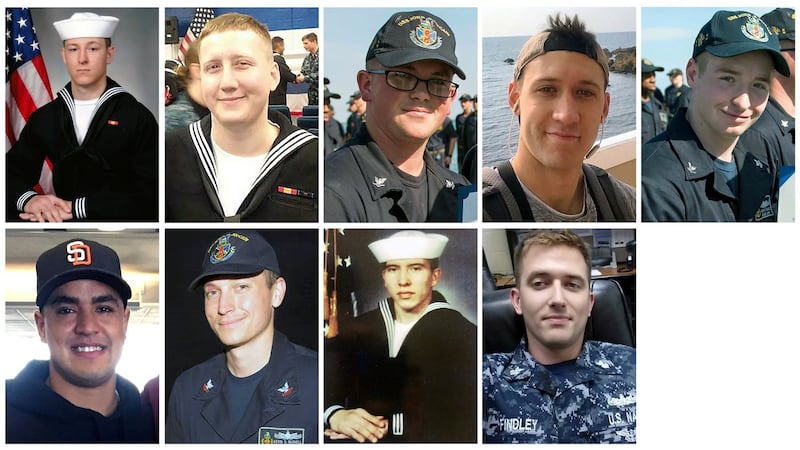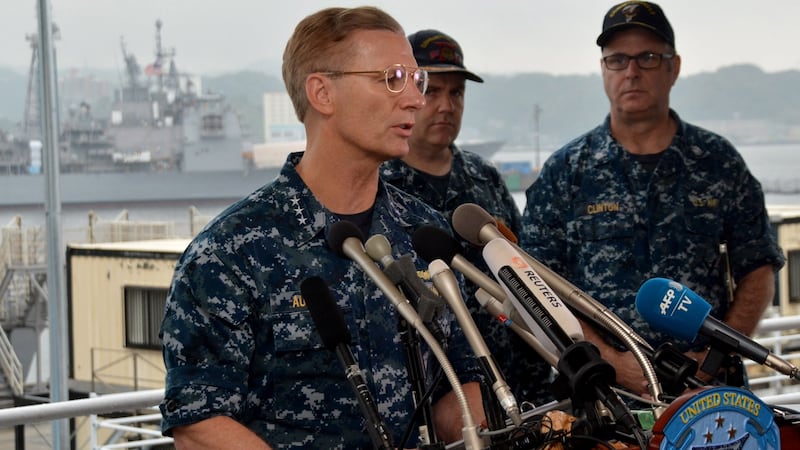Two deadly collisions between high-tech destroyers and easy-to-spot, slow-moving cargo ships in a little over two months have stunned many in the US navy and sent top leaders scrambling for answers. But shipboard veterans had long seen signs of trouble.
Factor in a shrinking navy performing the same duties that a larger fleet did a decade ago, constant deployments that leave little time to train and relentless duties that require sailors driving 9,000-ton vessels to endure sleepless stretches that would be illegal for bus drivers, and avoidable accidents can happen, current and former officers said.
“What seems impossible – that two ships could hit in the middle of the ocean – becomes very real,” said Robert McFall, a former navy lieutenant commander who served as the operations officer of the destroyer USS Fitzgerald in 2014. “If you are not at your best, events can start that lead to a disaster.”
Since the loss of 17 sailors after the Fitzgerald collided with a freighter near Tokyo in June, and a second destroyer, the USS John S McCain, collided with a tanker on August 21st while approaching Singapore, Navy investigators have been piecing together the causes of the fatal crashes. (On Sunday, the navy said it had recovered the last of the bodies of the 10 sailors who died on the McCain.) Congress has scheduled hearings next month that will include top commanders and safety auditors.
While there could be some surprising findings, officers said the accidents – and two non-lethal mishaps earlier this year – were almost certainly influenced by systemic problems that persist despite repeated alarms from congressional watchdogs and the Navy’s own experts.
In interviews, more than a dozen current and former ship commanders who served in the western Pacific said the strain on the navy’s fleet there had caused maintenance gaps and training shortfalls that had not been remedied or had received only cursory attention as leaders focused on immediate missions.
Compounding the stress, the officers and crew said, the navy allows ships to rely on gruelling watch schedules that leave captains and crews exhausted, even though the service ordered submarines to abandon similar schedules two years ago. The navy recognises that safety problems may go beyond what occurred on the two destroyers, and its examination of whether systemic issues contributed to the accidents will also review ship operations and episodes at sea over the past decade, with a focus on the western Pacific.
“This is truly a shock to the navy’s system,” Adm James Stavridis, a retired four-star admiral who commanded destroyers, said of the recent crashes. “It’s hard to believe it is simply coincidental.”
Vice-admiral William Douglas Crowder, a retired commander of the 7th Fleet and a former deputy chief of naval operations, agreed. "As the navy conducts this broad look in its mirror, I suspect it will recognise many blemishes that are neither new nor previously unknown," he said in an email.
“The key issue is whether the navy will commit to the fundamental changes required to actually cure those shortfalls.”
20,000 sailors
The 7th Fleet, based in Yokosuka, Japan, is the navy's biggest and busiest fleet, with 20,000 sailors and 50 to 70 vessels, including about a dozen cruisers and destroyers. Even as the navy has shrunk, its missions have grown to meet demands in a region that has become increasingly unstable.
"These ships are at sea constantly," said McFall, who left the navy in 2016. "Every time Kim Jong-un rattles his saber, these ships get under way," he added, referring to the leader of North Korea. "When the Chinese decide to build on a new island, these ships get under way. When under way, they are basically working around the clock. People get tired, and when they do, they make mistakes."
In the past two decades, the number of navy ships has decreased about 20 per cent, though the time they are deployed has remained the same, according to a 2015 report by the Center for Strategic and Budgetary Assessments, a Washington research group funded by the defence department. The increased burden has fallen disproportionately on the 7th Fleet.
"There are very few ships there, but the operational demands are enormous," said Kevin Eyer, a former navy captain who commanded cruisers in the western Pacific. That tempo, current and former navy officers said, has frayed readiness. Government and military investigators drew similar conclusions, warning that the mission pace was leaving crews unprepared.

A 2015 study by the Government Accountability Office, the investigative arm of Congress, found that the high demands of navy fleets based overseas, like the 7th in Japan, affect maintenance and training.
Investigators found that ships spent so much time at sea that there was not enough time for routine preventive repairs. And they said that while crews based in the United States were almost always completely qualified before deploying from their US ports, ships based overseas and juggling multiple missions relied on a "train on the margins" approach.
“In Japan, there are no dedicated training periods built into these ships’ operational schedules,” the accountability office’s report found. “As a result, these crews do not have all needed training and certifications.”
Young officers
The bridge of each navy destroyer is controlled by a round-the-clock shift of young officers, who must pass written and oral exams to qualify for the positions. Still, they typically are younger than 25 and may have little shipboard experience. Junior officers also move on to other assignments after limited tours.
“Are we short-changing their basic training, especially as we rotate our junior officers whose tours aboard ship are nominally 24 months?” Crowder said.
Training for junior ship officers has changed significantly in recent years. In 2003, the navy dropped what had been an intensive six-month training course on navigation, basic seamanship, engineering and maintenance before new officers were assigned to their first ship.
Instead, the new officers were sent directly to a ship where they were supposed to learn on the job. Some said they got practical training on deployments, and noted that the 7th Fleet had a reputation as being the most experienced in the navy. But, many commanders said, crews were too busy to provide that kind of instruction.
By last year, the navy had largely reversed course, sandwiching a junior officer’s first sea tour between 14 weeks of classroom work. Still, training has become an afterthought in the stressful environment on warships, some officers said. “Folks say the best way to learn how to navigate is to be out on missions,” Crowder said. “Well, not if you’ve missed the basics.”
Those junior officers have big responsibilities. Steering a 505 foot-long destroyer at night through busy shipping lanes, like those where the Fitzgerald and the John S McCain hit trouble, is far from simple. One captain compared it to barrelling along a crowded, snowy interstate highway with no marked lanes in a vehicle that weighs more than 300 tractor-trailers.
Operations aboard such ships are structured around safety, with an array of radar and sensors and sailors stationed on each side of the bridge and in the stern to scan the seas with binoculars. Back-up systems ensure that steering and engines do not fail. In many cases, the back-ups have back-ups.
These systems are designed to make the likelihood of collisions infinitesimally small. But, officers said, they remain vulnerable to human error, and small mistakes can cascade into calamities. Fatigue can raise the risks. Seasoned officers and navy studies have long warned of the perils of sleep deprivation, which sailors say is chronic. "I spent 30 years in the navy, which means most of my adult life I was dead tired," said John Cordle, a retired navy captain who commanded a destroyer and a cruiser. "Officers basically have a day job and a night job, plus drills."

Twice while commanding ships passing through narrow passages, he said, he fell asleep on his feet and his ship went off course. “Most of the officers I’ve talked to have a story like that,” said Cordle, who left the navy in 2013. “We just don’t always share it.”
He now works with the Naval Postgraduate School in Monterey, California, to devise better sleep schedules for crews, but he said the navy had been slow to adopt them.
‘Five and dime’
Most ships use a traditional “five and dime” watch rotation, in which sailors serve five hours of watch, then have 10 hours off, he said. But during those 10 hours, sailors often have daytime duties. The rotation can lead to a watch officer working a 20-hour day every three days, Cordle said, adding that even designated sleep time can be interrupted by drills or refuelling operations that can keep sailors up for days at a time.
A Government Accountability Office report from May said sailors were on duty up to 108 hours each week.
“I averaged three hours of sleep a night,” someone described as a Japan-based navy officer wrote on Reddit last week. “I have personally gone without sleep for so long that I have seen and heard things that weren’t there. I’ve witnessed accidents that could have been avoided because the person was so tired they had no right to be operating heavy machinery.”
Navy tests of sailors on the five-and-dime schedule found lack of sleep led to blunted decision-making and reflexes that were roughly the same as those of sailors who had downed several beers.
The Naval Postgraduate School has developed a shorter watch schedule to match circadian rhythms, which uses three hours of watch duty and nine hours off. Recognising the benefits, the navy ordered submarines to move to a similar schedule in 2015.
Cordle said adopting the schedule could result in greater safety. But the navy has left scheduling up to individual captains, and three-quarters of ships still use the five and dime. “The navy, like any big organisation, is resistant to change,” he said. “They know sailors aren’t getting enough sleep, but I think there is an expectation you can tough it out.”
New York Times service











